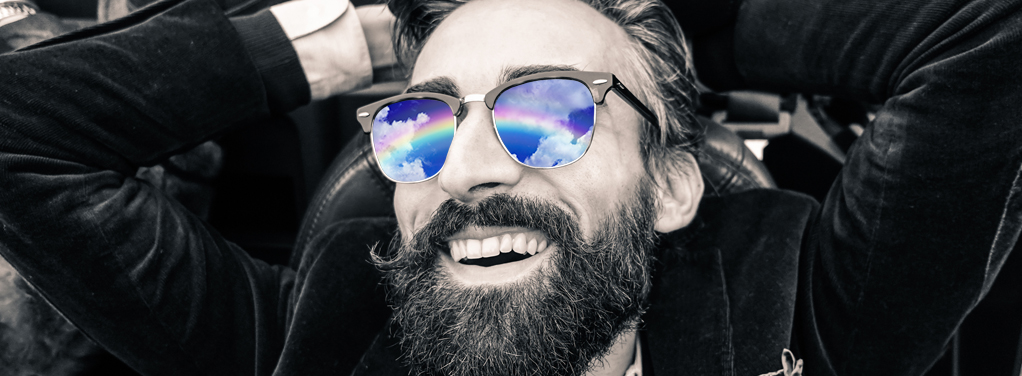Blog
Obscure Holiday Calendar for July
Breaking Out of Prism: Reflections on How the Rainbow Reigns in Corporate Branding
We’ve covered at length the positives and negatives colors can have on our psyche. And how companies have strategically utilized the positive aspects of a color to stimulate consumers’ emotions, build brand awareness and ultimately hawk their wares. But the beauty of choosing the rainbow as a signature “color” is that companies have hedged their bets in the knowledge there’s something for everyone.
Red is powerful, orange is exciting, yellow is fun, green is calming, blue is trustworthy, indigo is perceptive, and violet is charming. Rather than gamble on a single hue, corporations who incorporate ROY G. BIV into their business plan have upped the odds of hitting their target seven-fold. Smart.
Why do we love the rainbow so? As adults, we see it as the heavenly embodiment of the calm after the storm, a clean slate and a new day where anything is possible. For children, it’s much simpler—they simply love the bright colors. From infancy, as our sense of color developed, it’s our first fantastic sensory overload.
The use of rainbows in creative branding and product merchandising is known as Multicolored Marketing. And in terms of marketing to kids, make no mistake—you will find it everywhere.
Watches, clothing, sherbet, press-on nails, emoji poo, the list and demand is unending. And how effective and profitable it is kind of goes without saying.
Thanks to Multicolored Marketing, kids (of all ages) continue to eat up advertising for Willie Wonka’s irresistible Rainbow Nerds, and are quick to “Taste the Rainbow” Skittles so generously provides.
After twenty-eight years of being part of an unbalanced breakfast, General Mills decided it was time that Lucky the Leprechaun granted every child’s wish. In 1992, Lucky Charms included rainbow-colored marshmallows into their fruity mix. Right out of the box, it was magically delicious and deliciously successful.
But sweet indulgences aside, it’s the rainbow’s role in toys and games that’s proven to be the real game changer.
Hasbro’s My Little Pony franchise has been a staple in girls’ rooms since 1981, and continues to gallop with annual sales over a billion dollars. There are dozens of different characters each more adorable than the one before. However, since her 2003 debut, one of the highest-selling “darlings” of all is the brave and bold Rainbow Dash.
About the same time in the 80s, a greeting card company from Ohio gave children their first glimpse of “Those Characters from Cleveland,” better known as the Care Bears. Another billion-dollar franchise of books, LPs, music videos, video games and animated feature films (nine and counting), the list of Care Bear characters has extended to more than 218. And again, no surprise, but right at the top and close to the heart of their loyal fan base is Cheer Care Bear, the eternal optimist with a rainbow tummy.
Rounding out this triad of marketing triumphs is yet another branding bonanza from the early 80s from yet another card company. This time it was Hallmark, and their story centered around a young girl named Wisp, who battled the King of Shadows, liberated sprites and was thus forever known throughout the land as Rainbow Brite. Along with adventure books and captivating dolls, the brightly-colored franchise has continued to expand globally with lines of clothing, jewelry, furniture and bedding, not to mention the equally popular albums, games and full-length films. On a beautiful side note, for the first major TV campaign for Rainbow Brite dolls, the soundtrack was “Over the Rainbow.”
Sure, we could go on all day about the young ones. But regarding branding for the big kids, the most shining example of Multicolored Marketing occurred in 2015. In June of that year, a landmark decision was made and gay marriage became legal across America. For millions, it was a time of celebration. And for nearly as many companies it was a window of opportunity to show their support by “going rainbow.”
What made this trend so intriguing (ok, controversial) was that overnight, rainbow-colored advertising was everywhere.
Consumers saw a rainbow of new logos for Facebook, YouTube and Twitter, as well as for American Airlines, Uber, Absolut, Dominos and the Gap. Even Allstate went all in with colorful branding that offered new options for the new couples.
No one wanted to be cynical, but the arrival of so much so quickly gave consumers pause. Was it sincere support—or shrewd strategy?
For some companies, it was seamless. For others, it seemed forced and opportunistic.
But for all, one thing was clear. With this new era came new opportunities to either strengthen or reposition their brand by aligning it with a new world view of inclusion.
